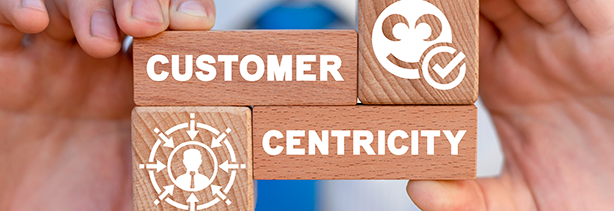Introduction
Customer centricity has been touted as a key driving force for many organizations in the last decade. The continuous change of customer expectations and behavior towards technological possibilities has accelerated the need for organizations to become more customer-centric. However, the hype around customer centricity has led many organizations to buy into it almost blindly, without properly knowing what it entails ([Roel16]). The result is that it is too often thrown around as a buzzword, without actual change in execution. And where organizations do indicate that they are customer-centric, this might be in name only. According to [VanB21], even as awareness of the benefits of what they call “customer obsession” has increased, there are no more organizations that could be reasonably labelled “customer obsessed” than there were in 2019.
Within many organizations, there are common pitfalls that prevent the organization from building a more customer-centric organization. Five of these pitfalls are described below. Though interrelated, each one highlights a different perspective on what to avoid to really foster customer centricity (see Figure 1). As many organizations have adopted Agile as their way of working, examples are given of how these pitfalls typically manifest in an Agile environment.
Figure 1. The five pitfalls. [Click on the image for a larger image]
Pitfall 1: Organization still based on product-centricity
Organizations continuously struggle in the transition from product centricity to customer centricity. A product-centric organization focuses on the products it markets, rather than the customers who buy those products. Product-centric organizations develop products based on a technology push and not a market pull (see Figure 2).
Figure 2. From product-centric to customer-centric. [Click on the image for a larger image]
The foundation of a customer-centric organization is market and user research that creates actionable insights into the problems customers face, the solution requirements, and the solution context ([SAFe21a]). Such an organization needs to be structured differently compared to a product organization ([Kruh16]). Preferably, a team or division should focus on one customer group – premium customers or young adults, for example – and, through research, design products for that segment ([Lee15]). This means focus is placed on delivering value to a customer (working value-driven).
In the context of an Agile organization, this pitfall can be recognized when different Agile teams that work on a product or service are not yet structured in such a way that they are focused on bringing value to a customer, instead, they are focused on different products offered. Within the SAFe framework this is solved by structuring the organization around value streams, which are defined by the steps, the people, and the flow of information and material necessary to deliver customer value. Value streams optimize the flow of value across divisions and functional departments and through the system as a whole to the customer ([SAFe21b]).
To put the customer first in the development of a product and aid the “market-pull” process, user stories are created by Agile teams. A user story is a small, self-contained unit of development work designed to accomplish a specific goal within a product. It is written from the user’s perspective and follows the format: “As [a user persona], I want [to perform this action] so that [I can accomplish this goal].” When a product-centric organization implements user stories, these stories tend to be based on untested assumptions of what a customer needs because they are still primarily driven by a technology push. To really make the shift towards customer centricity, and not just in name only, assumptions about the customer need to be validated through research.
Pitfall 2: Silos preventing exchange of information
Individual teams have valuable insights into customer expectations and pain points that could help to improve a product or service ([Sund19]). However, because of a siloed organizations structure treating departments and teams as separate islands, there is often a lack in communication and knowledge sharing between silos, e.g. between engineering teams and customer-facing departments like marketing or sales (see Figure 3). The misconception that customer centricity should be the sole responsibility of specified roles, like product managers or UX designers, contributes to this divide.
Figure 3. Silos prevent the exchange of information about customers. [Click on the image for a larger image]
It is not uncommon to come across “Agile” teams that are not even expected to directly interact with users or customers. For example, no actual customers are invited to the sprint demos, missing the opportunity for the team to gain early feedback and get aligned with customer needs from the source. Even worse, customer insights gathered by siloed departments don’t reach the team at all and are only cascaded down to the teams as a list of functionalities to be implemented.
To make sure that every employee understands the needs of a customer it is important to break down silos in your organization. Customer insights should be widely shared, direct interaction with customers should be facilitated and a customer-centric culture should be cultivated by implementing metrics that focus on impact on the customer (and not metrics that decrease cooperation between departments) ([Lee18]).
Pitfall 3: Lack of focus on root problem
Another pitfall that Agile teams should be careful of is the lack of customer centricity in the problem phase of the development process. Agile methodologies focus on incremental and customer-centric refinement with a product vision as a starting point ([Hild12]) – focusing on “building the thing right”. Here, customer centricity is mainly reflected in a focus on usability and user experience. However, customer centricity in terms of exploring the problem space, the core of the actual problem and different solution paths prior to gathering requirements and refining the solution – “building the right thing” – is not naturally part of Agile methodologies (see Figure 4). A lack of awareness, but also the focus on velocity, efficiency, and full backlogs and the subsequent lack of time are often reasons why Agile teams skip further problem exploration and validation. However, failing to consciously delve further into and validate problems might result in efficiently solving the wrong problem and building the wrong thing. This phase should therefore be intentionally included and prioritized.
Figure 4. Defining the right problems to solve and finding the right solutions to develop (Design Thinking), versus developing these in the right way (Agile practices). [Click on the image for a larger image]
Building customer centricity into the foundation of the development process might require organizational and process changes. It means time should be invested to take a step back to explore alternatives and to deep dive into the problem, even if you think you already have a great initial solution. Such a change requires top-down support and dedicated time, as well as a shift in mindset to focus on the root cause of the problem prior to focusing on the solution. Teaching Design Thinking competences and/or adding design specialists in the problem phase can help to include problem-oriented customer centricity, and in setting the scene for a successful product that people are happy to adopt and use.
Pitfall 4: Overlooking the dynamic nature of customer needs
Another pitfall entails the dynamic nature of customer needs and failure to recognize and anticipate this notion. This pitfall can be spotted when the problem phase is treated as a sequential phase instead of an iterative phase to continuously reflect on (see Figure 5).
Figure 5. The problem space and solution space need to be explored iteratively. [Click on the image for a larger image]
Within Agile teams, certain tools and techniques can be (and are) used to better understand the customer, their pain points and their needs, e.g. through Personas, Customer Journey Maps, Empathy Maps, etc. Treating the outcomes of these tools as static snapshots is a large and risky pitfall; this method is insufficient to keep up with the rapid pace of change that we’re facing nowadays. “Change is the only constant.” For example, Customer Journey Maps are often used as a starting point at the beginning of a development process. It should however be recognized that such a tool is not a box to check once, but rather a living document that can be used to support the customer-centric mindset throughout the process.
The key with regards to customer insights is not the presence or even the quantity of data, but how rapidly data can be updated and reanalyzed. This affects the use of tools and the process of involving customers/users. To set yourself and your team up for success, think about the setup and intent of dynamic customer centricity in your project. On the one hand that means specifying the tools and the method to keep the tools up to date (e.g. Miro, Mural, a shared PowerPoint over a static PDF or drawing). On the other hand, it means to intentionally include clients and/or users, e.g. in frequent and planned client retrospectives, to reanalyze and be up to date about their needs, pain points and touchpoints.
Pitfall 5: Lack of employee centricity
While many organizations place emphasis on being customer-centric in their strategy, actually embedding it throughout all levels of the organization proves to be difficult. What employees need specifically to operate in a customer-centric way is often overlooked. The pitfall here is failing to understand that to be customer-centric you need to be employee centric first. Beyond just understanding this notion, organizations need to know how to actually put this focus on the employee experience into practice.
A typical manifestation of this pitfall within organizations on their Agile journey can be found in teams that are task-oriented instead of driven by a purpose. These teams might be cross-functional and self-organizing to a degree, but often lack a direct connection to the customer. Consequently, they are unable to empathize with the customer and therefore lack a deep understanding of the business context. Team members are only concerned with finishing their user stories within the sprint, not with the continuous improvement of product and services to better satisfy customer needs.
Understanding the employee experience is key to empowering employees to put the customer at the center of the work they do. The way organizations service employees or internal customers must be as “customer-centric” as the way they service external customers. To help build a customer-centric culture, consider focusing on these three areas ([Hern20]) (see Figure 6):
- Enablement
Create an environment that allows employees to perform optimally. Organizations should build processes based on the needs and expectations of employees and continuously improve the supporting tools and services available to them. - Empowerment
Leaders at all levels should actively listen and ask important questions, rather than give orders and answers. They must trust and empower employees to make decisions about better ways to fulfill (internal) customer need. - Engagement
Engagement is about intrinsically motivated employees who are connected to the purpose and values of the organization. Encourage employees to work cross-functionally towards the same customer-centric purpose through joint goalsetting.
Figure 6. Empowerment, engagement and enablement are critical areas to be developed for the best employee experience. [Click on the image for a larger image]
Conclusion
The pitfalls mentioned in this article span a wide view on customer centricity: from organizational structure, to the way teams are organized, and the culture of daily work. They are meant to provoke thinking about possible barriers in becoming customer-centric, and how to break them down. Table 1 summarizes them in a table for easy reference. If you recognize any of these pitfalls in your own organization, this might be a sign that there’s still work to be done in paving the way to actually being customer-centric, not just in name only.
Table 1. A summary of the five pitfalls and how to avoid them. [Click on the image for a larger image]
References
[Hern20] Hernandez, J. et al. (2020). Making the connection: Employee experience drives customer experience. KPMG. Retrieved from: https://advisory.kpmg.us/content/dam/advisory/en/pdfs/2020/making-connection-employee-customer-experience.pdf
[Hild12] Hildenbrand, T. & Meyer, J. (2012). Intertwining lean and design thinking: software product development from empathy to shipment. In: Maedche, A., Botzenhardt, A., & Neer, L. (eds.), Software for People (pp. 217-237). Berlin/Heidelberg: Springer. Retrieved from: https://link.springer.com/chapter/10.1007/978-3-642-31371-4_13
[Kruh16] Kruh, W. & Freedman, P. (2016). Seeking customer centricity: The omni business model. 2016 Global Consumer Executive Top of Mind Survey. KPMG. Retrieved from: https://assets.kpmg/content/dam/kpmg/pdf/2016/06/seeking-customer-centricity-the-omni-business-model.pdf
[Lee15] Lee, J.Y., Sridhar, S., & Palmatier, R. (2015, July–August). Customer-Centric Org Charts Aren’t Right for Every Company. Harvard Business Review. Retrieved from: https://hbr.org/2015/06/customer-centric-org-charts-arent-right-for-every-company
[Lee18] Lee Yohn, D. (2018, October 2). 6 Ways to Build a Customer-Centric Culture. Harvard Business Review. Retrieved from: https://hbr.org/2018/10/6-ways-to-build-a-customer-centric-culture
[Roel16] Roelofs, J. & Cheung, L.Y. (2016). Customer Centricity: Het creëren van een customer-centric organisatie. Compact, 2016(4). Retrieved from: https://www.compact.nl/articles/customer-centricity
[SAFe21a] Scaled Agile Framework (2021). Customer Centricity. Retrieved from: https://www.scaledagileframework.com/customer-centricity/
[SAFe21b] Scaled Agile Framework (2021). Principle #10: Organize around value. Retrieved from: https://www.scaledagileframework.com/organize-around-value/
[Sund19] Sundaram, M. (2019). Design is not ‘nice-to-have’: Exploring good design and the business value of improving design capabilities within your organization. Compact, 2019(2). Retrieved from: https://www.compact.nl/articles/design-is-not-nice-to-have
[VanB21] VanBoskirk, S. (2021, June 11). The State Of Customer Obsession: Learn From The Habits Of More Mature Companies. Forrester. Retrieved from: https://www.forrester.com/report/the-state-of-customer-obsession/RES136701?objectid=RES136701












